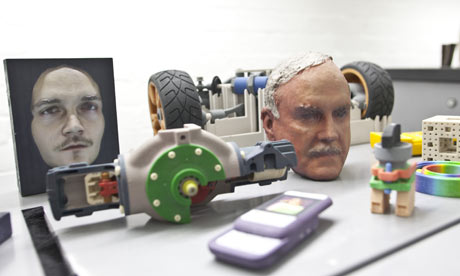 [div class=attrib]From The Guardian:[end-div]
[div class=attrib]From The Guardian:[end-div]
Enjoy eating goulash? Fed up with needing three pieces of cutlery? It could be that I have a solution for you – and not just for you but for picnickers who like a bit of bread with their soup, too. Or indeed for anyone who has dreamed of seeing the spoon and the knife incorporated into one, easy to use, albeit potentially dangerous instrument. Ladies and gentlemen, I would like to introduce you to the Knoon.
The Knoon came to me in a dream – I had a vision of a soup spoon with a knife stuck to its top, blade pointing upwards. Given the potential for lacerating your mouth on the Knoon’s sharp edge, maybe my dream should have stayed just that. But thanks to a technological leap that is revolutionising manufacturing and, some hope, may even change the nature of our consumer society, I now have a Knoon sitting right in front of me. I had the idea, I drew it up and then I printed my cutlery out.
3D is this year’s buzzword in Hollywood. From Avatar to Clash of the Titans, it’s a new take on an old fad that’s coming to save the movie industry. But with less glitz and a degree less fanfare, 3D printing is changing our vision of the world too, and ultimately its effects might prove a degree more special.
Thinglab is a company that specialises in 3D printing. Based in a nondescript office building in east London, its team works mainly with commercial clients to print models that would previously have been assembled by hand. Architects design their buildings in 3D software packages and pass them to Thinglab to print scale models. When mobile phone companies come up with a new handset, they print prototypes first in order to test size, shape and feel. Jewellers not only make prototypes, they use them as a basis for moulds. Sculptors can scan in their original works, adjust the dimensions and rattle off a series of duplicates (signatures can be added later).
All this work is done in the Thinglab basement, a kind of temple to 3D where motion capture suits hang from the wall and a series of next generation TV screens (no need for 3D glasses) sit in the corner. In the middle of the room lurk two hulking 3D printers. Their facades give them the faces of miserable robots.
“We had David Hockney in here recently and he was gobsmacked,” says Robin Thomas, one of Thinglab’s directors, reeling a list of intrigued celebrities who have made a pilgrimage to his basement. “Boy George came in and we took a scan of his face.” Above the printers sit a collection of the models they’ve produced: everything from a car’s suspension system to a rendering of John Cleese’s head. “If a creative person wakes up in the morning with an idea,” says Thomas, “they could have a model by the end of the day. People who would have spent days, weeks months on these type of models can now do it with a printer. If they can think of it, we can make it.”
[div class=attrib]More from theSource here.[end-div]
